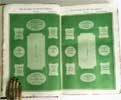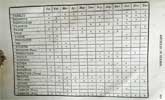THE COOK’S DICTIONARY, AND HOUSEKEEPER’S DIRECTORY:
A NEW FAMILY MANUAL OF COOKERY AND CONFECTIONARY, ON A PLAN OF READY REFERENCE NEVER HITHERTO ATTEMPTED. BY RICHARD DOLBY, LATE COOK AT THE THACHED HOUSE TAVERN, ST. JAMES’S STREET. NEW EDITION, CARFULLY REVISED; INCLUDING NUMEROUS NEW RECIEPTS, THE MOST APPROVED MODERN BILLS OF FARE, AND FASHIONABLE PLANS FOR LAYING OUT THE TABLE. LONDON: HENRY COLBURN AND RICHARD BENTLEY, NEW BURLINGTON STREET. [a small single line] 1833.
223 x 143 mm. 3rd Edition. 1fep. [1] Frontispiece. Title page. Half-title. [3] [1] 2p Advertisement to first and second editions. [1] 7p. Table layouts in Green. 4p. Bills of Fare. (1)2-552. 2p. Explanation. 7 p. Articles in Season. [1] 2p. Opinions of the press. 2feps. Frontispiece and title page slightly dusty. Text block slightly age browned. Half crimson calf with crimson tips and marbled paper. Spine with raised bands, gilt text and dentelles in the compartments.
- An interesting and alphabetically arranged presentation of early nineteenth century English domestic cuisine, compiled by chef Richard Dolby of the Thatched-House Tavern on St. James Street. At the time his book was a popular domestic reference. It contains several thousand entries and many recipes for cooking, baking, and brewing that had never before appeared in print. Featuring a glossary of cooking terms, and a number of alphabetical tables listing fish, crustaceans, fowl, fruit and vegetables when in season. First published in 1830 with a second edition appearing in 1832 and this last one printed in 1833 and also being the fullest and best edition. In researching the book, I came across a site online called ‘Grammerphobia’, described as Grammar, etymology, usage, and more, brought to you by Patricia T. O’Conner and Stewart Kellerman. It had an article entitled “Who put the Duck in Duck Sauce”. Following the logic of the question from Chinese recipes to Chinese American Cuisine to the classic French cooking, the question of the classic Duck Sauce Bigerade came about. It went on to explain; “One recipe for roast duckling appears under three names; Usually known as Duckling with Orange sauce or Duckling à l’Orange or Duckling à la Bigarade. Bigarade originally meant the orange itself, but in the 19th century it also came to mean a sauce made with bigarade oranges, served particularly with Roast Duck. Oxford’s first citation for the word used in this sense is from an 1833 edition of The Cook’s Dictionary, and House-Keeper’s Directory, by Richard Dolby. A recipe in the book for fillets of wild duck à l’orange advises; Arrange them in a dish, and serve with bigarade sauce under them. The sauce calls for the rind of a Seville orange. It also says that wild ducks should be fresh. If not fresh, on opening the beak they will smell disagreeable”. In researching Carrot Cake as well, I discovered the recipe in Richard Dolby’s book is an almost exact copy of the recipe ‘Gateaux de Carottes’ from ‘The Art of French Cookery’ written in 1827 by the famous French Chef A.B. Beauvillier’s. One wonders how many other recipes in Dolby’s book have been plagiarised. Further research is needed. --- Axford p.98. Bitting p.126. Oxford p. 164. Cagle p. 457.






click on image to enlarge

Antiquarian category
ref number:
11240